Ahead of the first leg, this was clearly one of the ties that people were most looking forward to as both RB Salzburg and Eintracht Frankfurt are among the best teams in the round of the last 32 in the UEFA Europa League. However, the first match in Frankfurt was not as tight as expected and Salzburg lost 4-1 away from home. Due to that, it already seemed clear, before the second leg even started, who would go through to the round of the last 16.
In this tactical analysis, we’ll look at both teams’ tactics and explain how Eintracht Frankfurt were able to get a 2-2 away from home to get through to the round of the last 16 in the UEFA Europa League.
Lineups
Jesse Marsch lined his team up in maybe the most offensive formation possible. Cican Stankovic was the goalkeeper while the back four in front of him consisted of Albert Vallci, André Ramalho, Jérôme Onguéné and captain Andreas Ulmer. Mohamed Camara was the only defensive midfielder while he was supported in the centre by Dominik Szoboszlai and Enock Mwepu. In front of them, Patson Daka, Hee-chan Hwang and Sekou Koita were quite flexible.
On the other side, Adi Hütter lined his team up in a 4-1-4-1 formation which was quite fluid as we’ll see in the upcoming sections of this tactical analysis. Kevin Trapp was between the sticks while the back four was made of Evan N’Dicka, David Abraham, Martin Hinteregger and Almamy Touré. Stefan Ilsanker was the only defensive midfielder while in front of him Sebastian Rode and Djibril Sow occupied the middle of the pitch. Filip Kostić and Daichi Kamada were the wingers and André Silva was the only striker upfront.
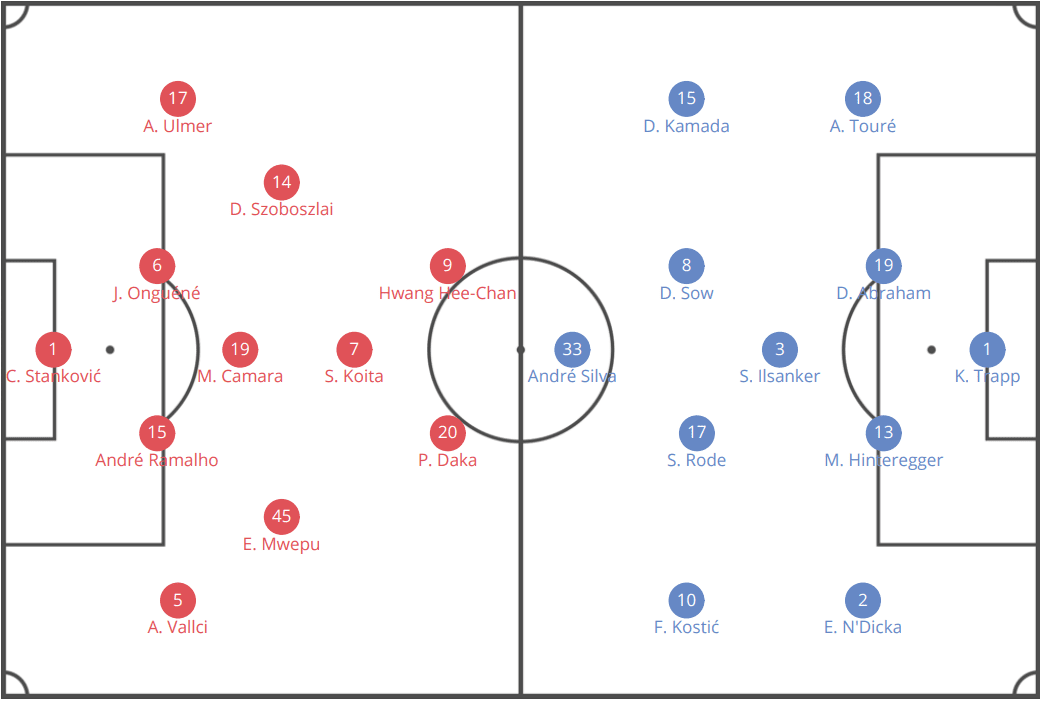
RB Salzburg’s build-up against the high press of Frankfurt
In general, we saw a game in which Salzburg needed and wanted to score as fast as possible to keep the chance alive after the 4-1 defeat in the first leg and due to that, they played as active, offensive and vertical as always. On the other side, Eintracht Frankfurt’s central goal was to avoid that Salzburg would even get into some kind of flow and don’t let them play their usual style of play. Due to that, Frankfurt used a high pressing system but also sat back deeper in their narrow 4-1-4-1 formation to give Salzburg no space in the centre.
Meanwhile, Marsch’s team stayed pretty much in their 4-diamond-2 formation during the build-up. The full-backs pushed a bit forward while the centre-backs were together with the defensive midfielder, Camara, responsible for the circulation of the ball during the first stage of the build-up. However, one of Frankfurt’s biggest goals was that they wanted to take Camara out of the game as soon as possible and created in the first half a kind of a diamond around him which consisted of the striker, Silva and the three central midfielders Rode, Sow and Ilsanker. As soon as the ball was played to him, they immediately put pressure on him to win the ball as we can see in the example below.
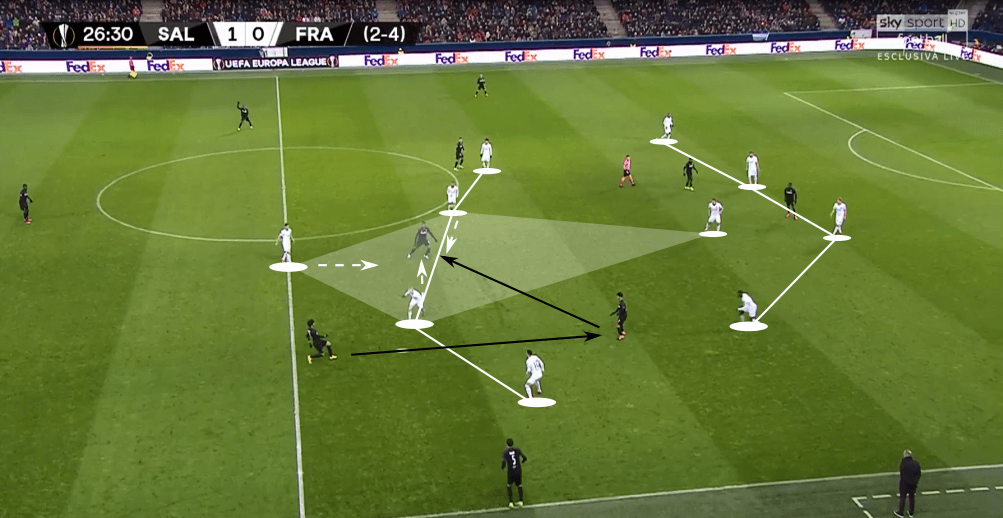
The young man from Mali did well in probably the biggest match of his career so far. Prior to the match, he was not the man in Salzburg’s squad picked for the big games but mainly gained experience in the Austrian Bundesliga. But since Salzburg’s first-choice defensive midfielder Zlatko Junuzović was out due to an injury, Camara was part of the starting XI and performed extremely well and was clearly among the best players in this game.
All in all, Salzburg did well during the first phase of the build-up as Frankfurt often tried to execute a high pressing, but Salzburg wanted to overcome that press with short passes and dribbles. Normally, you often can see that Salzburg plays long balls forward to either win the aerial duel, the second ball or start the counter-pressing. However, since Frankfurt had five players (back four and Ilsanker) in their defensive third who are all extremely strong in the air, they wanted to bypass the press to then play vertical through passes to exploit the space behind the defenders of Frankfurt with the enormous pace of Daka, Hwang and Koita.
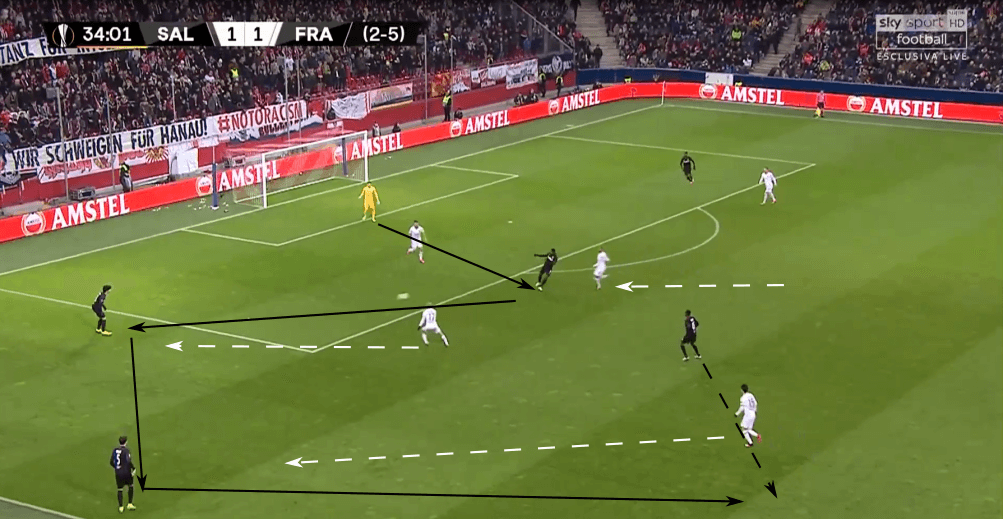
Also, since Frankfurt gave Camara no time to breathe as soon as he got on the ball, the centre-backs of Salzburg were responsible to progress the ball further up the pitch. They did well and especially Ramalho, who is normally not always that confident during the build-up played some great vertical passes through the centre. With Koita, Hwang and Daka, they had three men who moved in the centre between the lines of Frankfurt and together with the central midfielders Szoboszlai and Mwepu they permanently made sprints and runs to open up passing lanes for their teammates as we can see below.
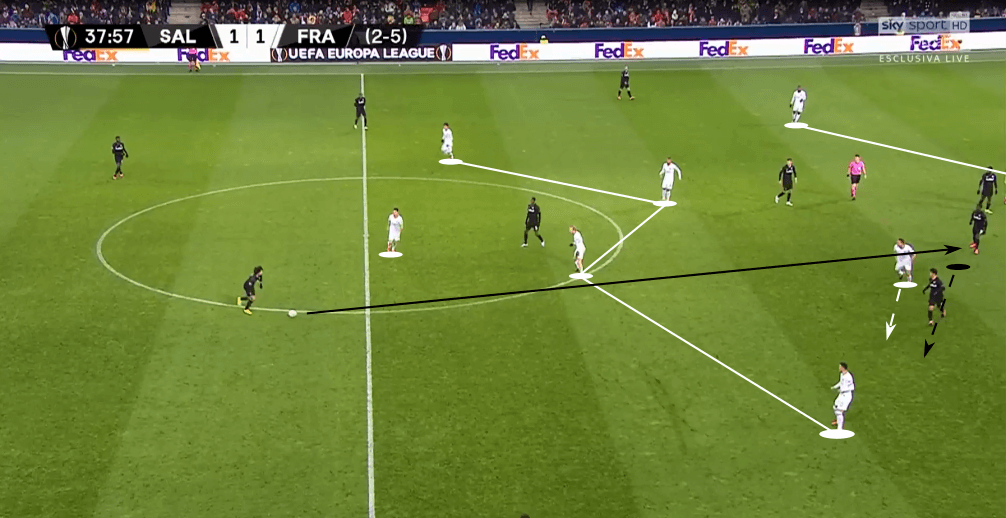
At the start of the second half, Hütter made one slight adjustment compared to the first half as he switched from a 4-1-4-1 with Ilsanker as the only defensive midfielder to a 4-2-3-1 and Sow dropped back to create a double pivot. This had two reasons as firstly he wanted one more player in the space in front of the defence to give Salzburg even fewer chances to get through the middle and additionally Rode (who was the number 10 behind Silva) fully focused on Camara during the periods of Salzburg’s possession.
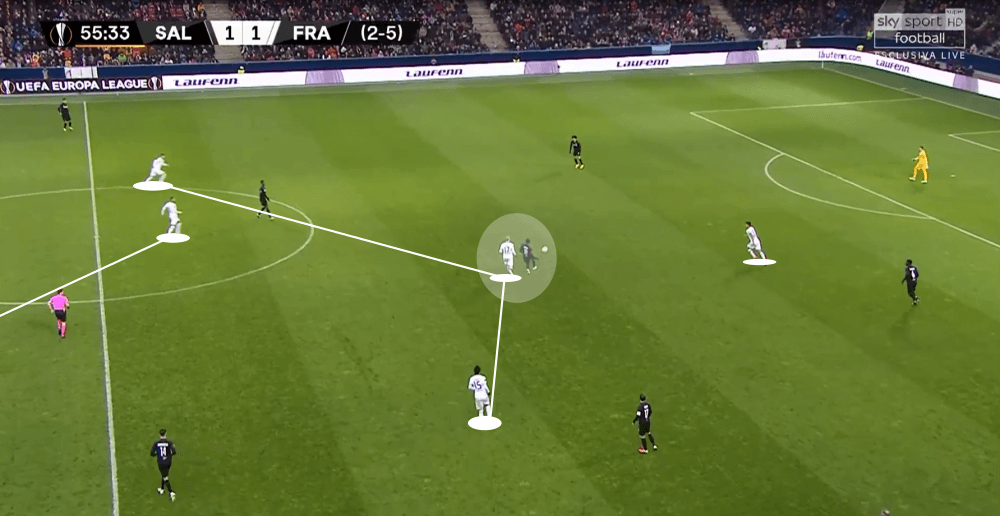
The wings as key areas for Salzburg
When we look at the formations of the two teams on the paper, we can instantly see that Frankfurt has numerical superiority on the wings as they have there two men on each side while Salzburg just had their full-backs in the wide-areas. This is normal for Salzburg since no matter with which system they go, their full-backs (or wing-backs) are the only ones who really provide any width. Even when they play with a 4-4-2, the wingers cut into a position in the half-spaces and the full-backs are the only one on the wings.
This was again the case in this match, as Szoboszlai and Mwepu mostly positioned themselves in the half-spaces to support the offensive players while Vallci and Ulmer were positioned wide. This had some advantages, but also some disadvantages. We can see, for example, a situation below where the ball is played wide to the right-back Vallci who has no single option for a pass even though there would be a lot of free space on his side.
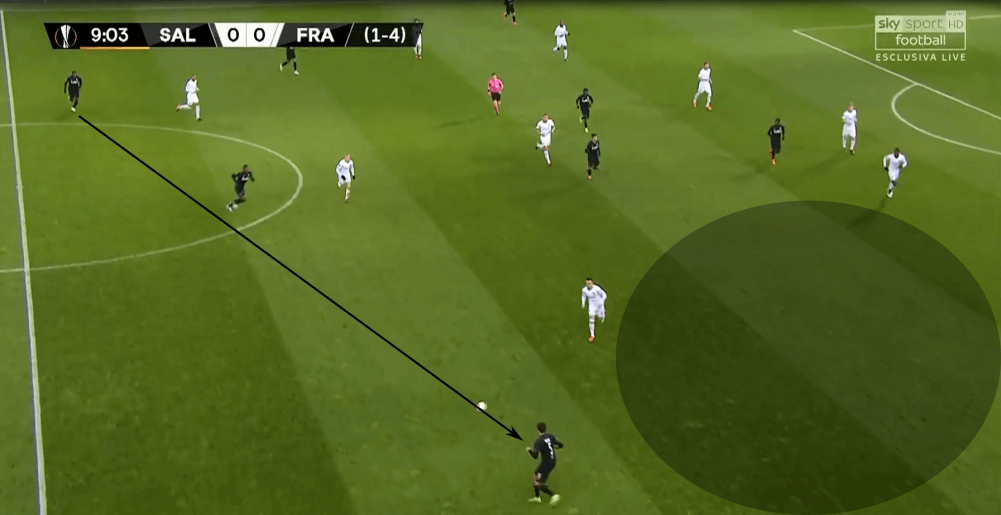
But you have to clearly distinguish between Salzburg’s left side and their right one. Firstly, Vallci is a much more defensive-orientated player compared to Ulmer on the left side. Additionally, Szoboszlai is more offensive-thinking than Mwepu and usually a left-winger. Due to that, he likes it to drift to the outside in some situations and help Ulmer.
Due to the many bodies which Salzburg had in the centre, Frankfurt’s 4-1-4-1 was extremely narrow and compact to avoid any passes and attacks through the centre and they did well since usually Marsch’s team wants to get into zone 14 and from there use the combination of short and quick passes to get in front of the goal. Frankfurt were able to avoid that but gave away a lot of free space on the wing, especially for Ulmer who was mostly positioned higher compared to Vallci.
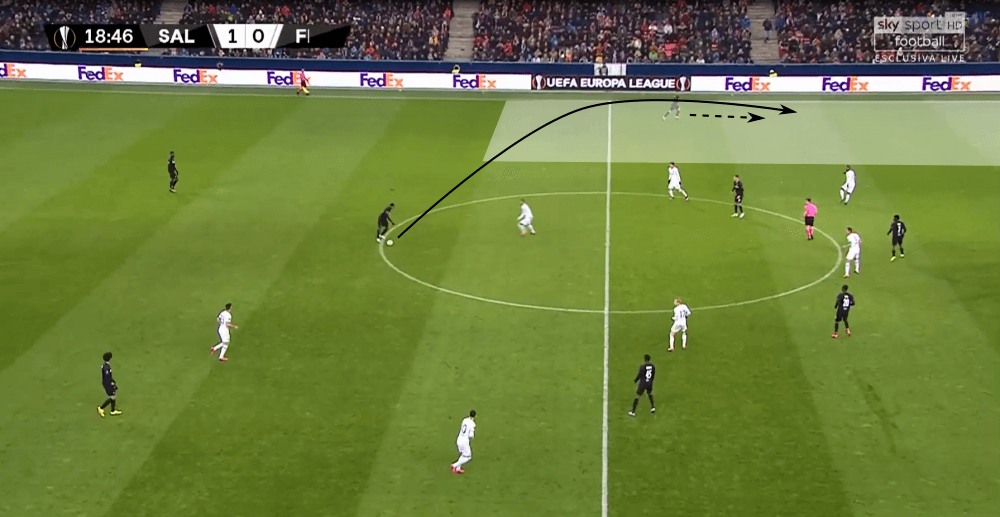
Salzburg tried several times throughout the game to exploit that free space on the wing with diagonal balls or quick switches from one side to the other as in the situation which can be seen above. This pattern was also the reason for the 1-0 as ahead of that, Eintracht once more were defending extremely narrow, but Salzburg were able to get from one wing to the other one with two quick passes through the centre to then give Ulmer enough space and time to score with a great shot from distance.
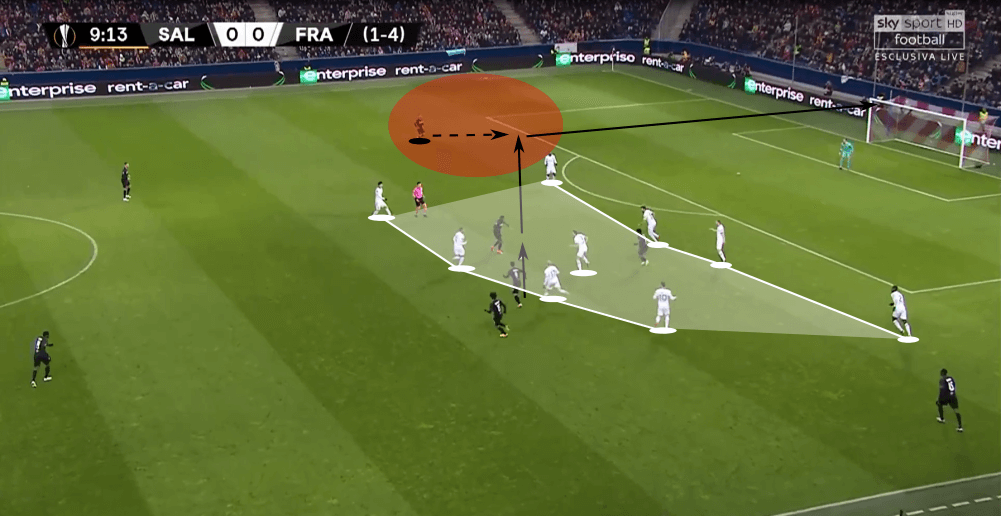
So, even though Marsch’s team was on paper the squad who had numerical disadvantages in the wide-areas, they were extremely effective there due to Frankfurt’s compact 4-1-4-1 formation. It’s questionable how dangerous RB Salzburg would have been if they had more space in the centre and less on the wing, but in general, it’s really hard to defend successfully against Salzburg.
Ulmer who was indeed one of the best players on the pitch showed in this game how dangerous he can be in the offence as he scored a brilliant goal and was in general one of the most impactful players of Salzburg during their attacks. He showed additionally some interesting movements and runs like that one in the shot below.
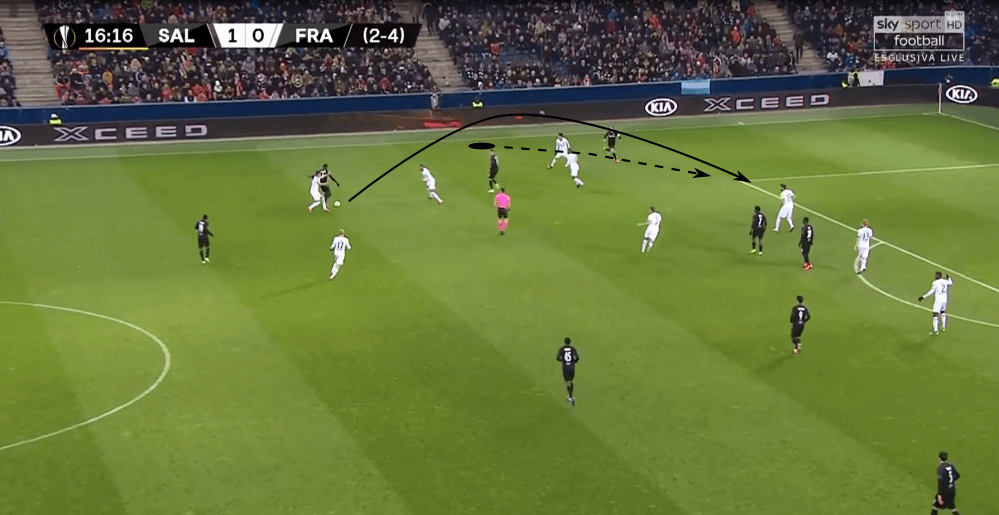
Frankfurt’s long balls
Even though Eintracht Frankfurt rarely built up their attacks with short passes from the back, we still will take a closer look at their tactics during the build-up and their offensive tactics overall. When they were in possession, Hütter’s team used an interesting asymmetric approach. Since Kostić on the left side is a natural wide player he stayed there while on the other wing, Kamada mostly tucked inside to position in the half-spaces and joined Rode and Sow in the centre. Due to that, the right-back Touré positioned slightly higher compared to his teammate on the other side N’Dicka. Ilsanker sometimes dropped between Abraham and Hinteregger to create a back three depending on N’Dicka’s position.
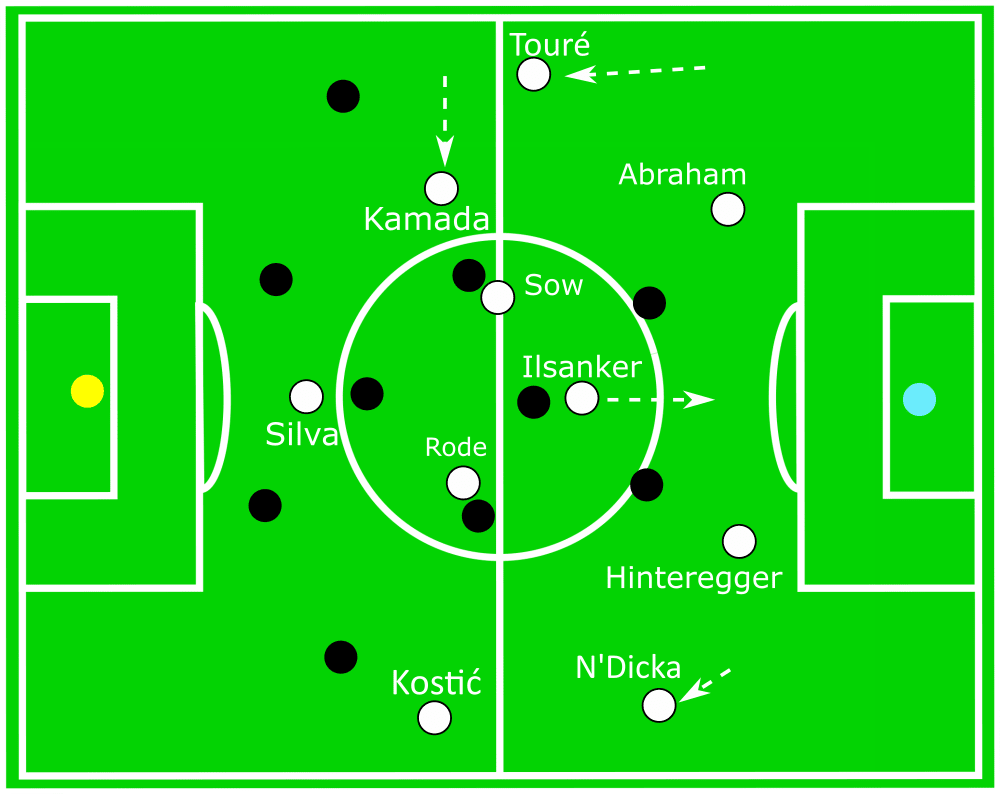
Now the big difference in this game between these two teams comes into play. Both sides executed a high and aggressive pressing for what both are well-known. However, the difference was that Salzburg wanted to bypass the press of Frankfurt and solve these situations with short passes and dribbles while on the other side Frankfurt mainly used long balls to then either win the second ball or start the counter-pressing. RB Salzburg man-marked ahead of every single goal-kick all short options for Trapp. Of course, they still had the chance to play it short and play out from the back, but they didn’t want to risk anything as they knew how effective Salzburg’s high pressing can be.
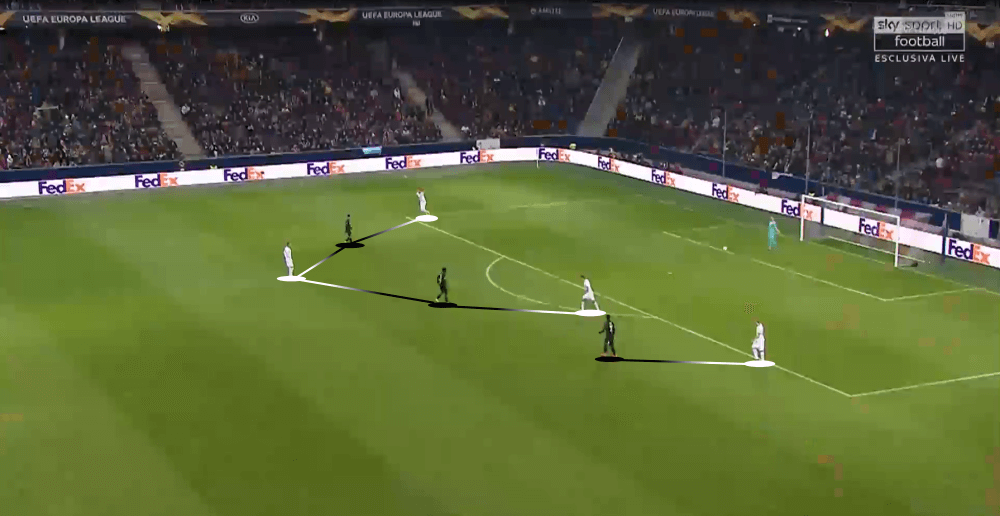
Also, as soon as Frankfurt were able to win back the ball, they instantly went long to find Silva upfront who should protect the ball until his teammates push forward and support him. The Portuguese striker was during the periods of possession and also the counter-attacks always the target for the long balls and in the shot below we can see an example during a moment of offensive transition.
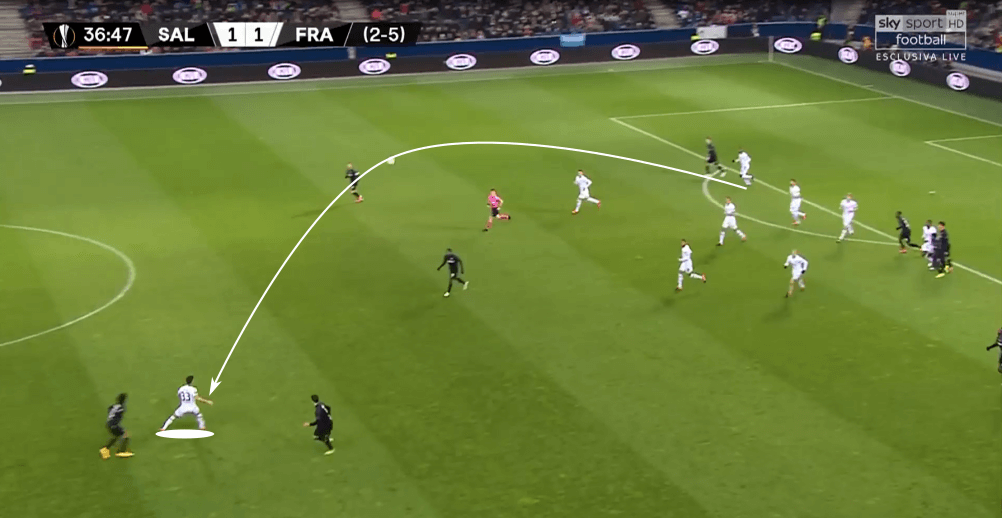
In the first half, Frankfurt were rarely able to create dangerous goalscoring opportunities as Salzburg were mostly able to win the second ball or overcome the counter-pressing with short passes and dribbles. Anyways, ahead of this match, it was clear that one of the central duels would be the one between Kostić and Vallci. While the Croatian is in this season one of the biggest stars of the Bundesliga, and already in the last summer it was reported that Inter would want to sign him, Vallci played in this match as right-back only due to the injury of Rasmus Kristensen. Of course, Vallci has improved game by game within the last few weeks because of the amount of playing time he’s received due to Kristensen’s injury. However, he was clearly the weak link in Salzburg’s back four. Due to that, Frankfurt tried several times to bring him into a sprint duel against Kostić and it payed off in the 30th minute as they found the Croatian winger with a good through pass in the space behind Vallci and Kostić then delivered the cross to assist Silva who scored the 1-1.
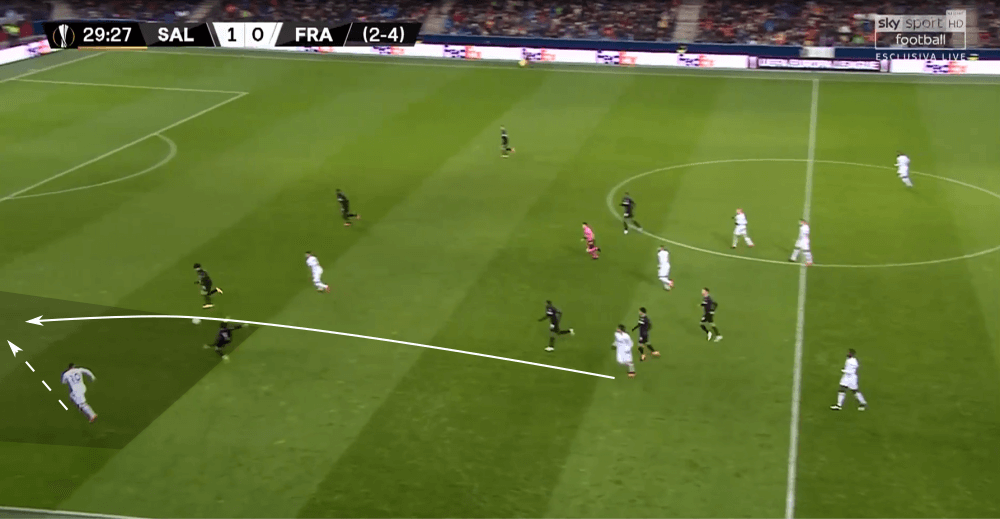
Basically, you have to add that Frankfurt rarely even tried to have a structured build-up to avoid Salzburg press. In the second half, Salzburg got even more offensive and Frankfurt had many chances for counter-attacks but were extremely sloppy. In the 83rd minute finally, one counter-attack led to the second goal of Silva which was the 2-2 and then it was clear that Frankfurt would be through to the next round. Still, we will now look at the period between the 66th minute and the second goal.
Noah Okafor’s introduction and the short period of hope
In Salzburg’s last victory, they bet Amstetten in the ÖFB Cup, and Salzburg’s latest big signing Noah Okafor made his debut for his new club as he played 10 minutes in this game. Since then, he remained on the bench for 90 minutes in the Austrian Bundesliga and in the first leg against Frankfurt he wasn’t even in the squad (they won none of these three games). In this match, he got subbed on in the 66th minute for Koita and had an instant impact. He played on the left side of the diamond while Szoboszlai was the offensive one instead of Koita.
Since Okafor is a natural winger, he gave Salzburg more width as he almost permanently positioned wide and that created space for Szoboszlai in some situations as he stretched the opposition’s formation as we can see below.
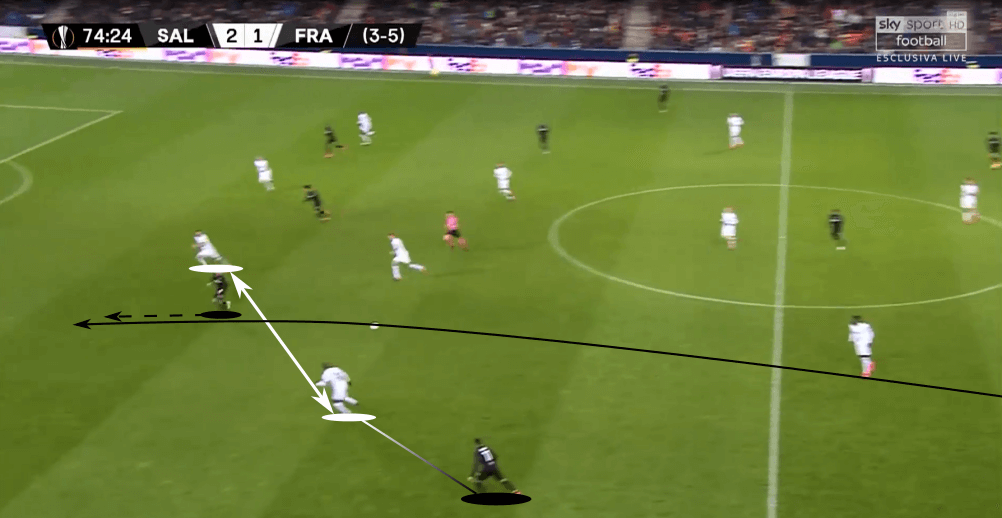
However, Okafor was also the player who was responsible for the creation of the situation which led to the corner out of which the 2-1 for Salzburg resulted then. Once more, he positioned pretty wide on the left wing to give his team some width. He then played a long diagonal pass into the centre towards the strikers Daka and Hwang. Even though the pass wasn’t perfect, it led to a corner since Frankfurt weren’t really able to defend this situation well and the corner then led to Onguéné’s goal.
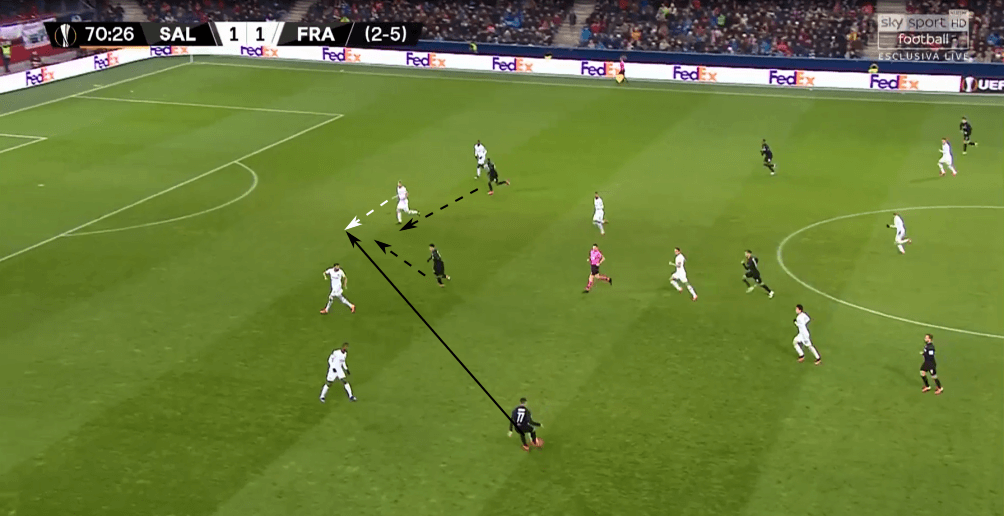
Also, you had the feeling that with Okafor and Szoboszlai, RB Salzburg could have the next dream duo. Both are extremely confident on the ball, have an outstanding technique, play in the same area of the pitch to be close to each other for link-ups and are both just 19 years old.
In several situations, the Hungarian offensive midfielder didn’t just use the space which Okafor created for him, but also came to the wide-area to support him and they tried together to break through on the left side with dribbles and short passing combinations.
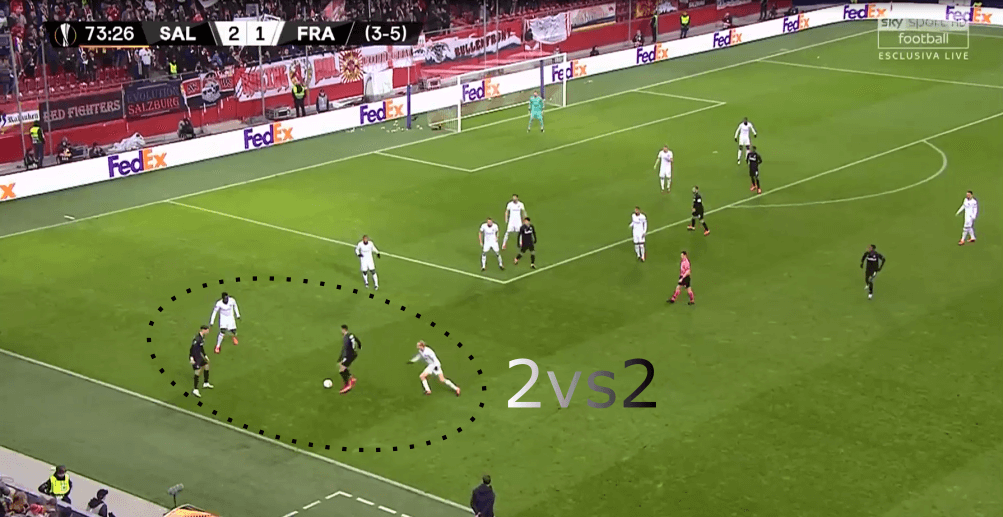
In the period after Okafor’s introduction in the game and of course the 2-2 which happened only five minutes later, Salzburg’s fans had once again hope and the stadium went crazy (until to the 2-2 by Silva). So, Okafor clearly brought back some freshness and helped to make it once more at least a bit thrilling. Anyways, Frankfurt reacted to this substitution and changed their formation to a 5-4-1 as Ilsanker dropped between Abraham and Hinteregger. This allowed the right full-back and wing-back respectively Touré to position wider and look after Okafor and Frankfurt had still enough men in the last line in the centre. Besides, Salzburg focused during the attacks not that primarily on the centre and due to with Rode and Sow they had enough men to defend in the central midfield.
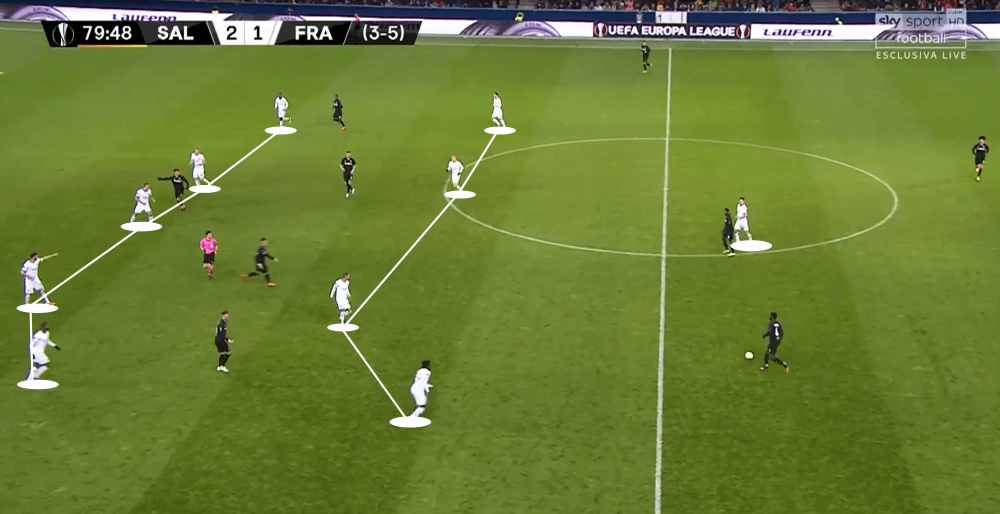
Conclusion
Salzburg showed a great performance and were brave enough to permanently try to bypass the press of Eintracht Frankfurt and were mostly successful while Hütter’s team played one long ball after another to not give Salzburg even the chance to execute their pressing. In the end, the individual class of Kostić and Silva was the deciding factor of the game.
Okafor showed a promising debut and could massively help Salzburg as he is now the only real winger in the squad and will continue to improve and adapt to the system of Salzburg. Eintracht Frankfurt will face FC Basel in the round of the last 16 and are clearly the favourites to go through in this clash.





Comments